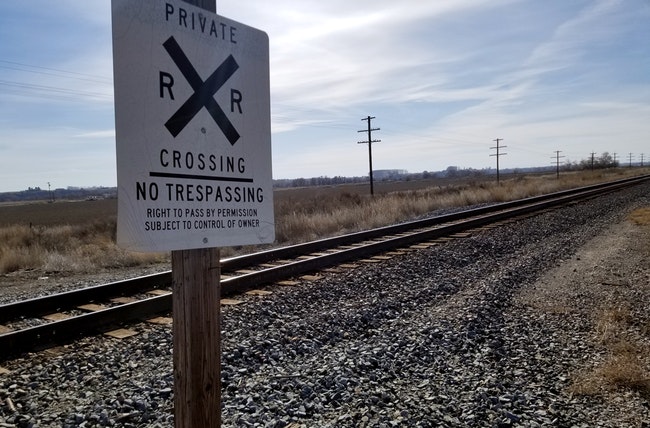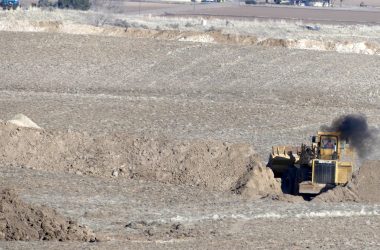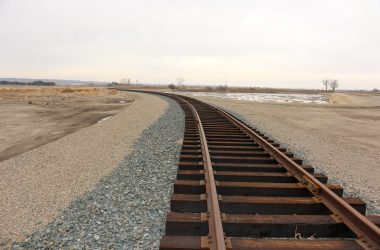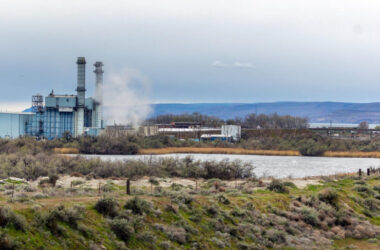
The rail reload center project still lacks a federal permit even as construction is slated to kick off in September. Officials also still do not have a signed agreement from the firm that is set to operate the facility. (The Enterprise/Pat Caldwell)
NYSSA – The Treasure Valley Reload Center continues to run into procedural snags that are slowing progress as it still lacks a key permit, the operator has yet to sign the lease and one proposed rail spur is being dropped for now.
The Malheur County Development Corp. found good news amid the delays, telling the state last week that Americold, the intended operator of the shipping center, has found a way to deliver the region’s onions at less expense than anticipated.
The impact of it all is unclear.
Greg Smith, director of the Malheur County Economic Development Department and project manager, didn’t respond to written questions or a telephone message.
He also warned the project’s chief engineer off from answering questions from the Enterprise, but the engineer answered anyway.
Officials at the Oregon Department of Transportation, stewards of $26 million in state money put up for the shipping center, remain supportive despite the hitches.
Construction once expected last spring and then by mid-August is now projected to start in mid-September with completion scheduled for next summer.
Contractors are under a deadline to bid by Aug. 25 for the initial work on the 285-acre site north of Nyssa. That will include earthwork to prepare for construction of the shipping center, rail lines and roads. The plans also call for working in wetlands.
Such wetlands work requires state and federal permits and project managers reported to the state last January that it had all such permits in hand. That wasn’t accurate because key permission from the U.S. Army Corps of Engineers remained unsettled.
And it still is, following a July 30 letter that criticized the work of Malheur County Development Corp. and the project engineering firm of Anderson Perry & Associates of La Grande.
“You have submitted information that is incomplete or unsubstantiated,” wrote Thomas Sentner, project manager for the Regulatory Branch of the Corps of Engineers.
Sentner said new engineering plans were needed, noting that the latest plans for the shipping center doubled the amount of wetlands to be worked on. The development company has 30 days from the date of the letter to submit more information.
The federal process then requires another 30 days for the public to review and comment on the latest plans.
Sentner advised the development company that no construction could start in the wetlands until the federal permit is issued.
In an email response to questions by the Enterprise Monday, Brad Baird, president of Anderson Perry & Associates, said the Corps of Engineers wants “significant detail and continues to ask for more information at each iteration.”
“We are trying to figure out just what they want, as it changes every time we talk to them. It is an iterative process. The Corps doesn’t take information at face value. You must prove it to them,” wrote Baird.
Smith on July 7 asked the state for permission to push back some of the project deadlines, citing the permit as one problem.
“Although we are working to secure the remaining permit prior to construction, it is not required for the initial work and will not preclude construction commencing,” Smith wrote. “Anderson Perry is working as quickly as possible to secure the finalized permit.”
He told the state that all permits would be in hand by Aug. 15, but that would be well before the federal permit could be issued because of the month-long comment period that hasn’t opened yet.
He repeated the Aug. 15 target in a later report to the state, dated Aug. 4.
He also said the start of construction was imminent.
“We look forward to awarding a qualified contractor at the end of August and breaking ground shortly thereafter,” Smith told the state.
Those contractors will have to work around the wetlands, which course through the farmland where the shipping center is going.
Smith and his team have struggled for months to meet federal requirements for the wetland work. Smith represented to the state for months that all such permits were in hand. That claim was key to a decision in January by the Oregon Transportation Commission to release millions of dollars to build the shipping center.
An investigation by the Enterprise, though, showed that the permit approvals were not complete from two critical agencies – the state Department of Environmental Quality and the Corps of Engineers.
Baird later insisted in an email to the Enterprise that “no permits have been denied or failed” but acknowledged that his company did resubmit the permits.
Records show that the Corps denied the wetland permit in April.
Baird in June told the development board that while the Corps permit still was in progress, “We are almost there. We will get it.”
Later that month, Baird told the board “We know what the requirement will be on the Corps of Engineers thing. With these timelines, we expect it to be in place prior to construction.”
At a July 13 meeting of the board, Baird promised the final permit would be ready before construction kicked off.
Baird wrote Monday that at the time, officials thought they “would just submit some revised information,” to the Corps. “We are in an iterative process over a few items the Corps is requiring additional information on.”
But the Corps days later concluded it didn’t have the details needed to go forward issuing the permit.
“On July 20, 2021, I considered your permit application for this project withdrawn because you had not submitted the information necessary for the Corps to continue,” according to Sentner’s letter.
According to Baird, his statements to the development corporation board in June and July were accurate at that time.
“We thought we were in a final iteration. We have had several conference calls with the Corps to try to come to completion with this permit,” Baird wrote.
Sentner said that new plans arrived on July 21 that “would result in greater wetland loss than what was previously proposed.”
The revised plans remained “incomplete,” Sentner wrote.
According to Baird, the back-and-forth dialogue with the Corps on permits is routine during construction projects the size of the rail center.
“The process can be very difficult, depending on what staff you get assigned by the Corps, and how difficult they chose to make it. Some permits go through more easily than others. There are many factors that affect the permit process,” wrote Baird.
Baird said the Corps can be “can be more difficult on some permits, less on others.”
Officials at the state Transportation Department weren’t aware of the continuing permit problems until questioned last week by the Enterprise.
“This is the first we have heard of this issue with the permitting process. Our team is reaching out to the MCDC team for an update,” said Cooper Brown, Transportation Department assistant director.
Baird said the Transportation Department wasn’t informed because it “doesn’t prefer that level of detail.”
Baird wrote his firm plans to submit key information to the Corps this week.
The land along the Union Pacific Railroad tracks north of Nyssa picked for the rail center includes a network of old irrigation ditches and wetlands. Wetlands are carefully managed by the state and the federal government because they act as a filter to clean water, provide erosion control, trap carbon and provide habitat for wildlife, including threatened or endangered species.
On many construction projects, wetlands can be filled in one place and replaced – or mitigated – elsewhere.
The development company initially planned to mitigate 1.79 acres of wetlands but in its revised application proposed mitigating 2.9 acres.
The Corps can’t issue a permit “if the proposed project is not the least environmentally damaging practicable alternative,” wrote Sentner.
Sentner also indicated there may be a substantial change in the layout for the rail center, directing the development company to “revise the drawing to remove Track C if this is not part of the proposal.”
Baird confirmed that the $29 million budget for the project “will likely not allow” the construction of Track C, saving money on both rail and earthwork.
The shipping center “will be a little less efficient, but will still be able to meet rail needs,” Baird wrote.
That track is one of spurs intended to hold rail cars for loading and shipping. Smith and his team have said nothing publicly about eliminating one spur.
But the Corps also suggested to Smith that there were two other ways to design the rail system to minimize the impact on wetlands. One would be to eliminate one more spur or shift the proposed location of the spur. Such changes could require new engineering work.
Another key requirement from the state remains unfinished as well – a legally-binding agreement between the county’s development company and Americold. The agreement sets the lease terms for Americold to run the Nyssa facility for the next 20 years.
Smith earlier this year said the deal would be done by June 15. That date came and went without Americold signing, and Smith didn’t respond to questions about why it hadn’t.
Instead, Smith submitted a letter to the state from Americold saying it intended to sign the lease.
State officials said that was a technical violation of the mandate requiring a “fully executed” document, but the Transportation Department was willing to overlook it and allow new deadlines to be set as part of the agreement for the $29 million.
“ODOT continues to work with MCDC to revise the agreement as appropriate while encouraging MCDC to make reasonable and timely progress,” Brown said in an email Friday to the Enterprise.
In early July, Smith told the state that Americold would sign the deal by July 31.
“As Americold is a very large, publicly-owned company, obtaining a signature on their behalf is no small feat. In no way does this delay the TVRC project in terms of construction,” Smith reported. “Americold has assured that we will receive their signature prior to the July 31 date.”
A month later, Smith reported the deal still wasn’t done. This time, the explanation was a change in the project.
“Americold intended to have signed the lease agreement no later than July 31st, however they recently discovered greater efficiencies that can be obtained,” Smith said in an Aug. 4 report. “New shipping destinations will reduce rates for local shippers as well as decrease shipping times.”
His report didn’t explain why lower rates would affect the lease.
The Transportation Department told the Enterprise that “Americold has identified some additional opportunities that in their opinion could make the operation of the proposed facility more advantageous to the state.” The state said it “agreed to provide more time for Americold to work those issues before completing and signing an operator agreement.”
News tip? Contact reporter Pat Caldwell at [email protected]
Previous coverage:
Nyssa rail project gets another $3 million in public funds to get water
WATCHDOG: Nyssa rail center, public money, and a most unusual deal
EXCELLENCE IN JOURNALISM – Available for $5 a month. Subscribe to the digital service of the Enterprise and get the very best in local journalism. We report with care, attention to accuracy, and an unwavering devotion to fairness. Get the kind of news you’ve been looking for – day in and day out from the Enterprise.




